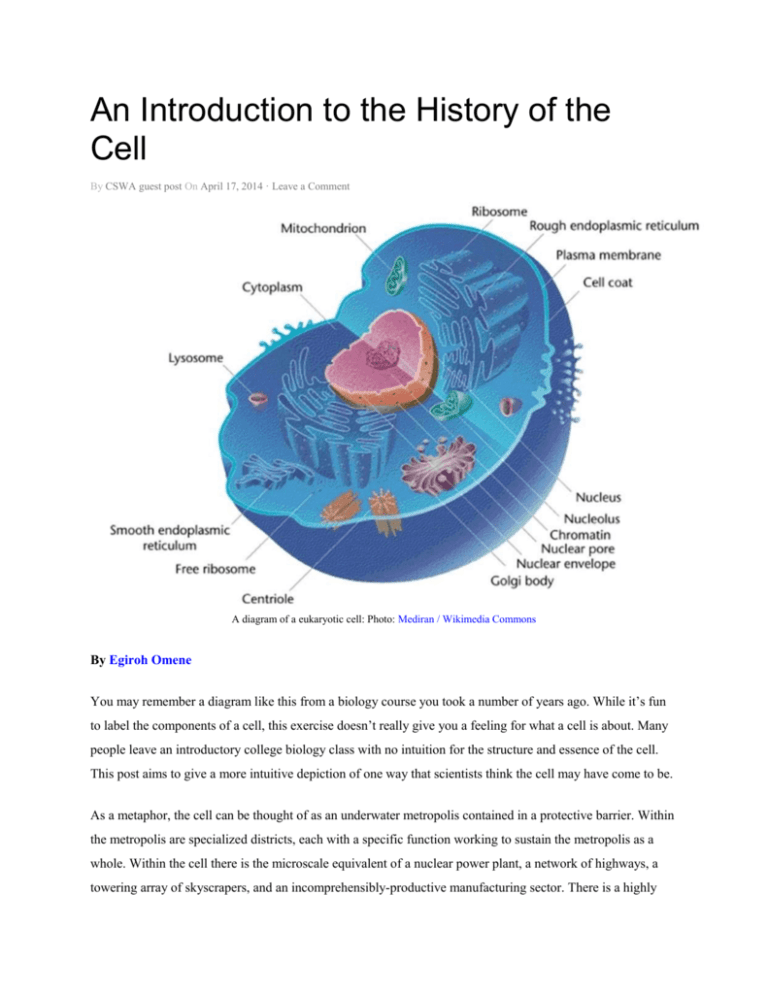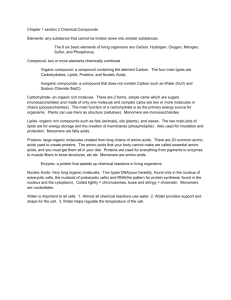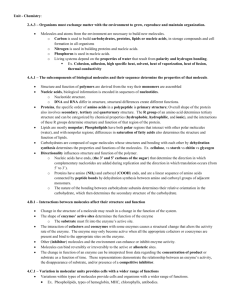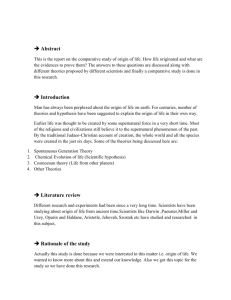History of the Cell
advertisement

An Introduction to the History of the Cell By CSWA guest post On April 17, 2014 · Leave a Comment A diagram of a eukaryotic cell: Photo: Mediran / Wikimedia Commons By Egiroh Omene You may remember a diagram like this from a biology course you took a number of years ago. While it’s fun to label the components of a cell, this exercise doesn’t really give you a feeling for what a cell is about. Many people leave an introductory college biology class with no intuition for the structure and essence of the cell. This post aims to give a more intuitive depiction of one way that scientists think the cell may have come to be. As a metaphor, the cell can be thought of as an underwater metropolis contained in a protective barrier. Within the metropolis are specialized districts, each with a specific function working to sustain the metropolis as a whole. Within the cell there is the microscale equivalent of a nuclear power plant, a network of highways, a towering array of skyscrapers, and an incomprehensibly-productive manufacturing sector. There is a highly refined waste removal system, and a grand repository of information containing the city’s blueprint (which also instructs the city’s destiny.) It’s a dynamic place with a million different components whizzing and whirling about. It’s a far cry from the static image you might’ve experienced in an intro biology course. How Did the Cell Come to Be? Let’s rewind a few billion years, to a time when most of the Earth was covered in ocean, and the atmosphere was markedly different than today. This early atmosphere was populated by a handful of simple, inorganic compounds, such as nitrogen, oxygen and carbon dioxide. This early Earth had the right temperatures and conditions to allow these simple, inorganic compounds to react and create more complex organic molecules. Just Add Heat, Electricity… Voila! With a handful of inorganic molecules, just the right amount of heat, and a bit of electricity you can create many of the basic molecules we see in life. In a general sense, the molecules of life are a collection of organic molecules that are common to every living thing. More specifically, they are the sorts of things you might find on a nutritional label: fat, carbohydrates, amino acids (which make up proteins), and nucleic acids. As these complex organic molecules formed, they found their way from Earth’s atmosphere and into the Earth’s oceans. These building blocks of life and these building blocks of cells are simple to make. But how do you construct a city without cranes and a construction crew? And who gives the orders? From Organic Mélange to Organized Cell This is where things get even more interesting. Again, imagine the cell as a metropolis, submerged in water and sealed shut by a barrier. In a cell, this barrier is essentially a thin film of fat. Think of what happens when a drop of oil hits water—it sticks to itself forming a sphere of oil separate from the water. This is the same sort of process that created the spherical barrier we call the cell membrane. Now, the actual cell membrane gets a little more complicated, but on a basic level we can see how its structure is created. A subset of molecules created in the atmosphere had this ‘oil-in-water’ property and provided the cell’s barrier. The formation of the membrane is a key component of the cell. The membrane separates the inside of the cell (and all that happens there) from the outside of the cell (and all that happens there). This is an obvious but important point. Now, imagine that as each of these spheres of fat form they capture a population of those complex organic molecules referenced before: a little nucleic acid, some carbohydrates, some amino acids. Instead of floating around aimlessly, though, with nucleic acids going here, amino acids going there, and carbohydrates doing whatever, a subset of the nucleic acids have a special property: some nucleic acids embrace and hold on to specific amino acids every time they come in contact. This bringing together of amino acids is the fundamental process of construction in living things, and the subset of nucleic acids in question is DNA, deoxyribonucleic acid. This selective behavior forms the basis of the synthesis of proteins from amino acids. It is simple and it is magical. These amino acids are versatile parts, and at the instruction of DNA the amino acids have gone on to be assembled into a variety of things: pumps, propellers, highways and skyscrapers. Complexity from Chaos At every point, notice that something has happened to increase complexity and order. First it was the creation of complex molecules from the early atmosphere. Next, a unique and separate microenvironment was formed within the nascent cell membrane, a process that trapped and separated a collection of the complex molecules from the world outside of the membrane. Then, one set of these organic molecules created complex structures from the molecules floating within the membrane-enclosed compartment. It is through this sort of process–of developing complexity and order–that the cell was built. And soon, from the individual cell we had communities of cells. These cells formed organisms–the sorts of organisms that themselves became more and more complex, going on to swim, fly, and run across the Earth. From inorganic compounds, to complex organic molecules, to life. This is quite the journey.










